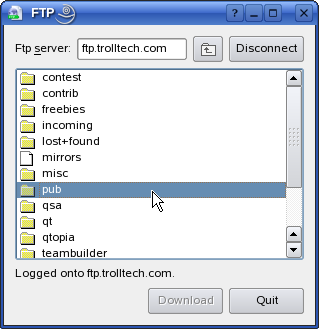FtpWindow Class Implementation
We skip the FtpWindow constructor as it only contains code for setting up the GUI, which is explained in other examples.
We move on to the slots, starting with connectOrDisconnect().
void FtpWindow::connectOrDisconnect()
{
if (ftp) {
ftp->abort();
ftp->deleteLater();
ftp = 0;
If ftp is already pointing to a QFtp object, we QFtp::Close its FTP connection and delete the object it points to. Note that we do not delete the object using standard C++ delete as we need it to finish its abort operation.
...
ftp = new QFtp(this);
connect(ftp, SIGNAL(commandFinished(int, bool)),
this, SLOT(ftpCommandFinished(int, bool)));
connect(ftp, SIGNAL(listInfo(const QUrlInfo &)),
this, SLOT(addToList(const QUrlInfo &)));
connect(ftp, SIGNAL(dataTransferProgress(qint64, qint64)),
this, SLOT(updateDataTransferProgress(qint64, qint64)));
fileList->clear();
currentPath.clear();
isDirectory.clear();
If we get here, connectOrDisconnect() was called to establish a new FTP connection. We create a new QFtp for our new connection, and connect its signals to slots in FtpWindow. The listInfo() signal is emitted whenever information about a single file on the sever has been resolved. This signal is sent when we ask QFtp to list() the contents of a directory. Finally, the dataTransferProgress() signal is emitted repeatedly during an FTP file transfer, giving us progress reports.
QUrl url(ftpServerLineEdit->text());
if (!url.isValid() || url.scheme().toLower() != QLatin1String("ftp")) {
ftp->connectToHost(ftpServerLineEdit->text(), 21);
ftp->login();
} else {
ftp->connectToHost(url.host(), url.port(21));
if (!url.userName().isEmpty())
ftp->login(QUrl::fromPercentEncoding(url.userName().toLatin1()), url.password());
else
ftp->login();
if (!url.path().isEmpty())
ftp->cd(url.path());
}
The Ftp Server line edit contains the IP address or hostname of the server to which we want to connect. We first check that the URL is a valid FTP sever address. If it isn't, we still try to connect using the plain text in ftpServerLineEdit. In either case, we assume that port 21 is used.
If the URL does not contain a user name and password, we use QFtp::login(), which will attempt to log into the FTP sever as an anonymous user. The QFtp object will now notify us when it has connected to the FTP server; it will also send a signal if it fails to connect or the username and password were rejected.
We move on to the downloadFile() slot:
void FtpWindow::downloadFile()
{
QString fileName = fileList->currentItem()->text(0);
...
file = new QFile(fileName);
if (!file->open(QIODevice::WriteOnly)) {
QMessageBox::information(this, tr("FTP"),
tr("Unable to save the file %1: %2.")
.arg(fileName).arg(file->errorString()));
delete file;
return;
}
ftp->get(fileList->currentItem()->text(0), file);
progressDialog->setLabelText(tr("Downloading %1...").arg(fileName));
downloadButton->setEnabled(false);
progressDialog->exec();
}
We first fetch the name of the file, which we find in the selected item of fileList. We then start the download by using QFtp::get(). QFtp will send progress signals during the download and a signal when the download is completed.
void FtpWindow::cancelDownload()
{
ftp->abort();
}
QFtp supports canceling the download of files.
void FtpWindow::ftpCommandFinished(int, bool error)
{
#ifndef QT_NO_CURSOR
setCursor(Qt::ArrowCursor);
#endif
if (ftp->currentCommand() == QFtp::ConnectToHost) {
if (error) {
QMessageBox::information(this, tr("FTP"),
tr("Unable to connect to the FTP server "
"at %1. Please check that the host "
"name is correct.")
.arg(ftpServerLineEdit->text()));
connectOrDisconnect();
return;
}
statusLabel->setText(tr("Logged onto %1.")
.arg(ftpServerLineEdit->text()));
fileList->setFocus();
downloadButton->setDefault(true);
connectButton->setEnabled(true);
return;
}
The ftpCommandFinished() slot is called when QFtp has finished a QFtp::Command. If an error occurred during the command, QFtp will set error to one of the values in the QFtp::Error enum; otherwise, error is zero.
if (ftp->currentCommand() == QFtp::Login)
ftp->list();
After login, the QFtp::list() function will list the top-level directory on the server. addToList() is connected to QFtp::listInfo(), and will be invoked for each entry in that directory.
if (ftp->currentCommand() == QFtp::Get) {
if (error) {
statusLabel->setText(tr("Canceled download of %1.")
.arg(file->fileName()));
file->close();
file->remove();
} else {
statusLabel->setText(tr("Downloaded %1 to current directory.")
.arg(file->fileName()));
file->close();
}
delete file;
enableDownloadButton();
progressDialog->hide();
When a Get command is finished, a file has finished downloading (or an error occurred during the download).
} else if (ftp->currentCommand() == QFtp::List) {
if (isDirectory.isEmpty()) {
fileList->addTopLevelItem(new QTreeWidgetItem(QStringList() << tr("<empty>")));
fileList->setEnabled(false);
}
}
After a List command is performed, we have to check if no entries were found (in which case our addToList() function would not have been called).
Let's continue with the the addToList() slot:
void FtpWindow::addToList(const QUrlInfo &urlInfo)
{
QTreeWidgetItem *item = new QTreeWidgetItem;
item->setText(0, urlInfo.name());
item->setText(1, QString::number(urlInfo.size()));
item->setText(2, urlInfo.owner());
item->setText(3, urlInfo.group());
item->setText(4, urlInfo.lastModified().toString("MMM dd yyyy"));
QPixmap pixmap(urlInfo.isDir() ? ":/images/dir.png" : ":/images/file.png");
item->setIcon(0, pixmap);
isDirectory[urlInfo.name()] = urlInfo.isDir();
fileList->addTopLevelItem(item);
if (!fileList->currentItem()) {
fileList->setCurrentItem(fileList->topLevelItem(0));
fileList->setEnabled(true);
}
}
When a new file has been resolved during a QFtp::List command, this slot is invoked with a QUrlInfo describing the file. We create a separate row for the file in fileList. If fileList does not have a current item, we set the new item to be the current item.
void FtpWindow::processItem(QTreeWidgetItem *item, int )
{
QString name = item->text(0);
if (isDirectory.value(name)) {
fileList->clear();
isDirectory.clear();
currentPath += "/" + name;
ftp->cd(name);
ftp->list();
cdToParentButton->setEnabled(true);
#ifndef QT_NO_CURSOR
setCursor(Qt::WaitCursor);
#endif
return;
}
}
The processItem() slot is called when an item is double clicked in the File List. If the item represents a directory, we want to load the contents of that directory with QFtp::list().
void FtpWindow::cdToParent()
{
#ifndef QT_NO_CURSOR
setCursor(Qt::WaitCursor);
#endif
fileList->clear();
isDirectory.clear();
currentPath = currentPath.left(currentPath.lastIndexOf('/'));
if (currentPath.isEmpty()) {
cdToParentButton->setEnabled(false);
ftp->cd("/");
} else {
ftp->cd(currentPath);
}
ftp->list();
}
cdToParent() is invoked when the the user requests to go to the parent directory of the one displayed in the file list. After changing the directory, we QFtp::List its contents.
void FtpWindow::updateDataTransferProgress(qint64 readBytes,
qint64 totalBytes)
{
progressDialog->setMaximum(totalBytes);
progressDialog->setValue(readBytes);
}
The updateDataTransferProgress() slot is called regularly by QFtp::dataTransferProgress() when a file download is in progress. We use a QProgressDialog to show the download progression to the user.
void FtpWindow::enableDownloadButton()
{
QTreeWidgetItem *current = fileList->currentItem();
if (current) {
QString currentFile = current->text(0);
downloadButton->setEnabled(!isDirectory.value(currentFile));
} else {
downloadButton->setEnabled(false);
}
}
The enableDownloadButton() is called whenever the current item in fileList changes. If the item represents a file, the Enable Download Button should be enabled; otherwise, it is disabled.























